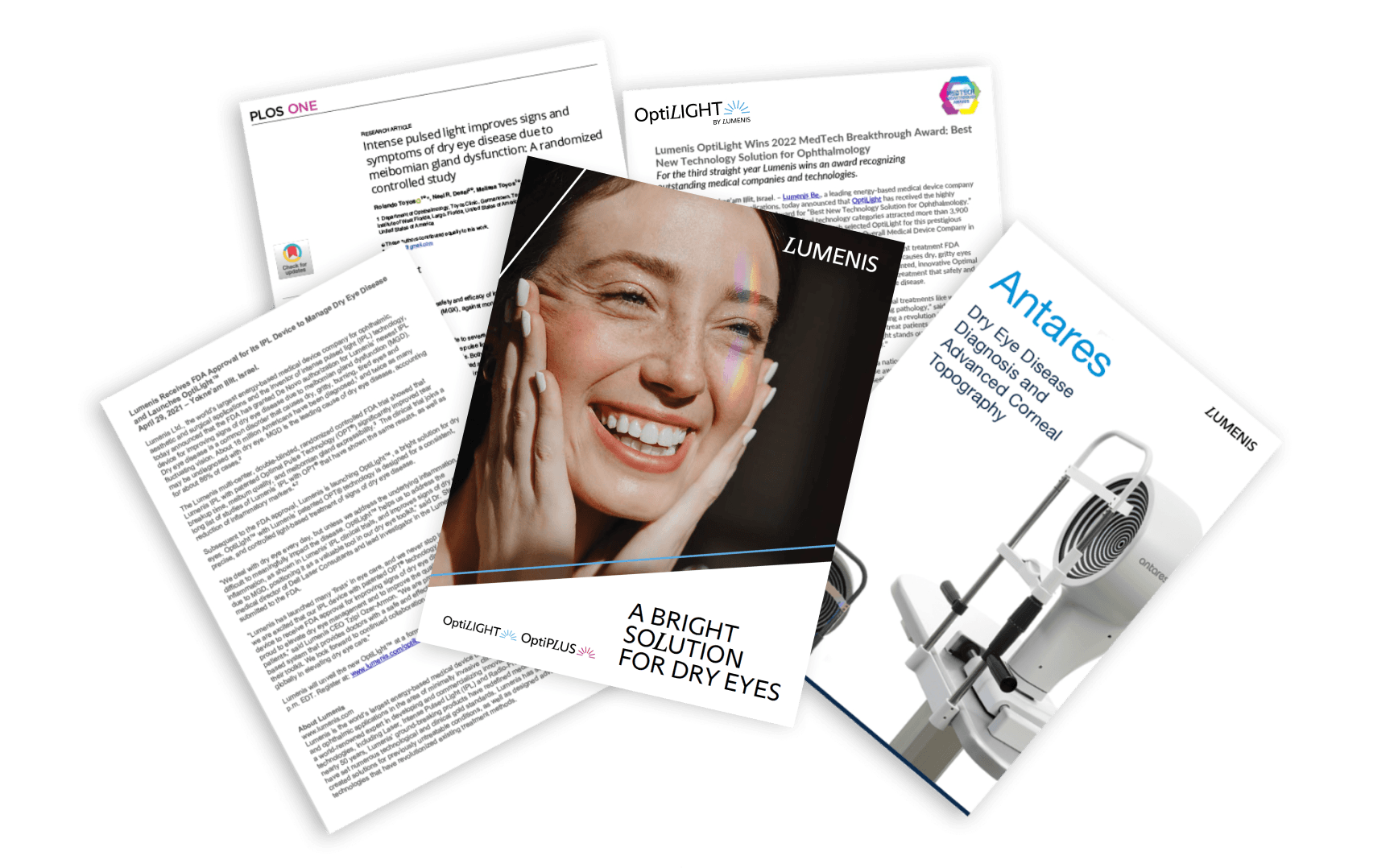Enhance Patient Care with the Sequential Use of OptiPLUS & OptiLIGHT

Lehigh Eye Specialists, Allentown, Pennsylvania
While building a dedicated dry eye disease clinic within an MD/OD practice, I’ve made OptiLIGHT the foundation. I chose Lumenis light therapy because it is the first and only option that is FDA-approved for dry eye management. To me, OptiLIGHT’s advanced capabilities make it uniquely suited to this multifactorial disease. It targets the root cause of dry eye while addressing key components, including inflammation, improving the meibomian gland morphology and function, reducing the bacterial burden, and diminishing Demodex.1,2,3,4 Nearly all my patients with moderate to severe dry eye receive OptiLIGHT as part of their treatment plan.
When Lumenis introduced OptiPLUS, the first-of-its-kind dual-frequency RF technology, I was eager to bring it into our clinic as a complementary treatment to OptiLIGHT to enhance patient care. OptiPLUS seamlessly integrates into my treatment paradigm and my clinic’s fast-paced, high-volume workflow. My patients love the results of these treatments and the aesthetic effects.
A Complement to OptiLIGHT
Like OptiLIGHT, OptiPLUS is safe, gentle, and comfortable. It is also FDA-cleared (a prerequisite in my practice) and can be used to treat a wide range of skin types. Patients have four treatment sessions, just like with OptiLIGHT. Although I’ve only had OptiPLUS for a few months, I recommend it to every OptiLIGHT patient as a complementary treatment.
With OptiPLUS, we apply innovative dual-frequency RF energy on the skin in the peri-orbital area, reaching every delicate curve. This unique technology delivers heat across skin tissue layers, enhancing blood circulation and collagen production while targeting the meibomian glands.5,6,7 thinning the meibum requires sustained heat, which is difficult to achieve with a mask or compress. By combining dual-frequency RF with IPL technology, we can express meibomian glands more effectively, see clearer meibum, and observe signs improvement.8
One key difference between OptiPLUS and other RF technologies is that it uses a monopolar application rather than a bipolar application. I prefer the monopolar RF method for my patients’ treatment because it mitigates the risk of electrical arcing, offers a more rapid and even heating of deeper eyelid tissue, and features a uniform and rounded device design better suited for delicate areas and efficient gland expression. These factors enhance safety and provide my patients with a more comfortable experience.
When I started using OptiLIGHT, I was focused on dry eye and saw any aesthetic benefits as an added bonus. Through OptiLIGHT’s upgradeable configuration, I soon realized the demand for the aesthetic aspects of the treatment among my patients. The addition of OptiPLUS enhances aesthetic results, promoting collagen production and skin rejuvenation.6,7 Thus, these supplementary treatments have opened the door to a new revenue stream.
OptiPLUS Packaging and Workflow
Implementation started with new packages and a workflow plan. We now offer a total of five packages, three of which contain dual-frequency RF treatment. One package includes four sessions of OptiPLUS + meibomian gland expression (MGX) for patients who fall outside the appropriate Fitzpatrick skin types for OptiLIGHT. Another package includes four OptiLIGHT sessions (dry eye protocol) + OptiPLUS + MGX. Finally, our aesthetics package consists of four sessions of OptiLIGHT (aesthetics protocol) + OptiPLUS + MGX. We were able to seamlessly integrate these packages into our current workflow by establishing protocols and delegating tasks when necessary.
My conversation with patients hasn’t changed. After first discussing their dry eye story and test results, I then make a recommendation. For example, I might say, “The exam and tests showed that meibomian gland dysfunction and inflammation are driving your dry eye disease..”
By packaging OptiLIGHT and OptiPLUS together from the start, I ensure success for my patients in terms of meeting clinical outcomes, and for my practice in terms of ROI. We had paid off our OptiPLUS device within three months and have continued improving patients’ quality of life.
Having a dedicated dual-frequency RF device has significantly improved patients’ symptomatology and meibomian gland function. While costs are out-of-pocket, it is a nice addition to the practice to offer a treatment that not only delivers real results but also elevates the in-office experience. By offering your patients both OptiLIGHT and OptiPLUS sequentially, you can maximize the potential of the technologies.
Patient conversion to OptiLIGHT has consistently been high, and I expect this trend to continue when paired with OptiPLUS, which promises potential for future volume growth. Patients love their treatment. I’m happy that we’ve been able to rely so heavily on OptiLIGHT over the years, and now we are able to enhance patient care by complementing it with OptiPLUS.
Discover new
possibilities
Download OptiLIGHT and OptiPLUS info kit

Explore Other Resources
[1] Kassir et al. (2011) J Cosmet Laser Ther 13(5):216-22
2 Papageorgiou et al. (2008) Br J Dermatol 159(3):628-32
3 Yin et al. (2018) Curr Eye Res 43(3):308
4 Prieto et al. (2002) Lasers Surg Med 30(2):82-5
5 Rabkin, J. M., & Hunt, T. K. (1987). Local heat increases blood flow and oxygen tension in wounds. Archives of Surgery, 122(2), 221–225. https://doi.org/10.1001/archsurg.1987.01400140103014
6 Javate, R. M., Cruz Jr, R. T., Khan, J., Trakos, N., & Gordon, R. E. (2011). Nonablative 4-MHz dual radiofrequency wand rejuvenation treatment for periorbital rhytides and midface laxity. Ophthalmic Plastic and Reconstructive Surgery, 27(3), 180–185. https://doi.org/10.1097/IOP.0b013e3181fe8e5a
7 Al-Atif, H. (2022). Collagen Supplements for Aging and Wrinkles: A Paradigm Shift in the Fields of Dermatology and Cosmetics. Dermatology Practical & Conceptual, 12(1), e2022018. https://doi.org/10.5826/dpc.1201a18
8 Chelnis, J., Garcia, C. N., & Hamza, H. (2023). Multi-Frequency RF Combined with Intense Pulsed Light Improves Signs and Symptoms of Dry Eye Disease Due to Meibomian Gland Dysfunction. Clinical Ophthalmology, 17, 3089–3102. https://doi.org/10.2147/OPTH.S426564
9 Green, J. B., Dover, J. S., & Kaminer, M. S. (2011). Tolerability of a Monopolar Radiofrequency Facial Skin Tightening Procedure: An Observational Study. https://cdn.mdedge.com/files/s3fs-public/Document/September-2017/024070327.pdf
*Per the FDA’s cleared submission, OptiPLUS is not intended to be used within the orbital rim or on the neck.
**OptiPLUS is cleared for use in the United States as a standalone device and not as a combination device with other therapies.
PB-00081290, Rev A